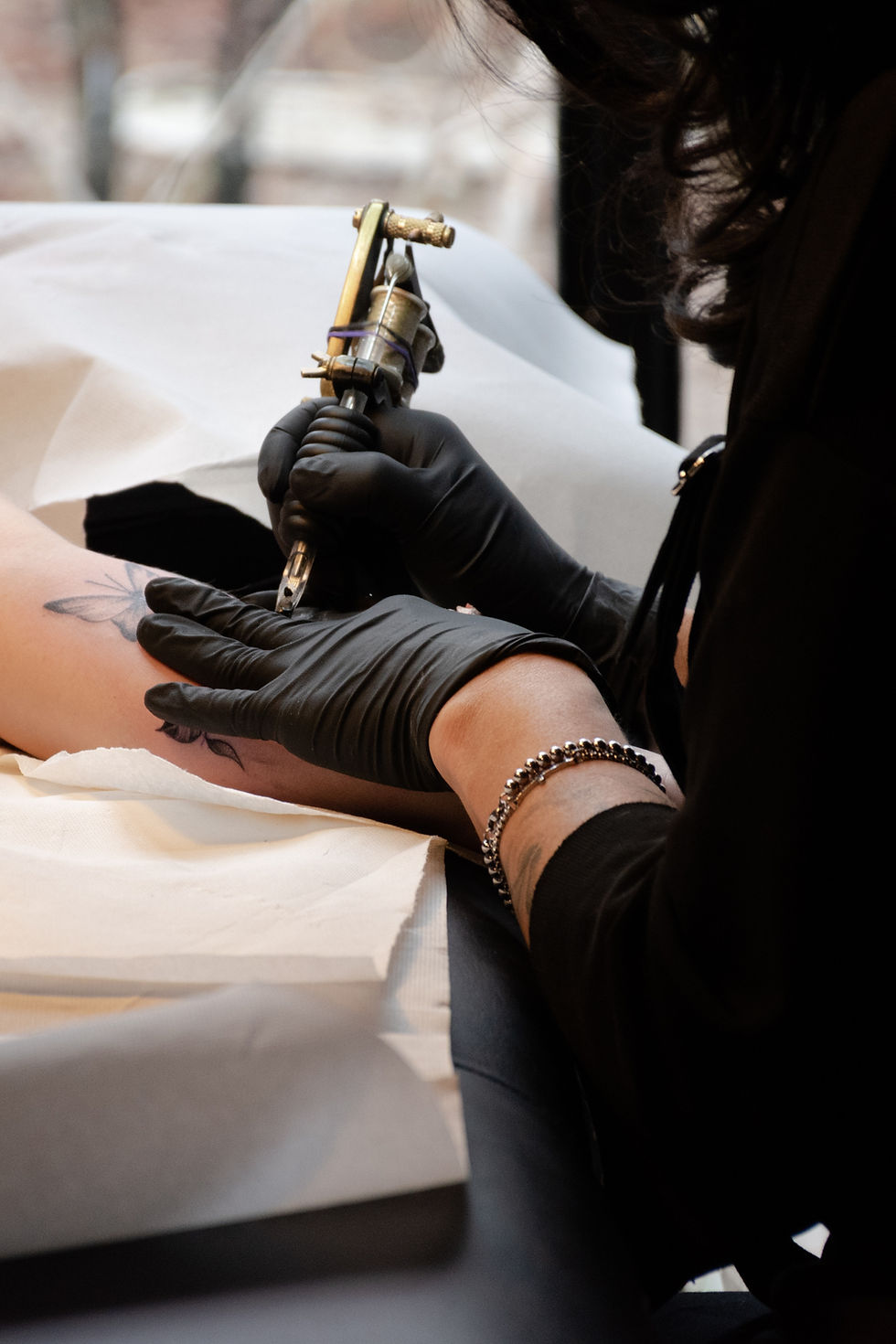How to Cover or Refresh an Old Tattoo: Touch-Ups, Reworks, and Cover-Ups
- Oxblood.ink

- Mar 26
- 5 min read
Tattoos are permanent, but they’re also personal and ever-evolving. As we grow and change, so do our tastes, and sometimes that means wanting to update, refresh, or completely change an old tattoo. Whether your tattoo has faded over the years, you’re no longer happy with the design, or you just want something new, there are several options for giving your old ink a new lease on life.
In this post, we’ll break down the different ways to approach refreshing or covering up an old tattoo, including touch-ups, reworks, and full cover-ups. Each approach offers a unique way to update or transform your tattoo, and knowing the right option for you can help you breathe new life into your ink.

1. Touch-Ups: Reviving Faded Ink
Tattoos naturally fade over time, especially if they’re in areas exposed to sunlight, or if the ink wasn’t applied as deeply as it should have been. Fading is a normal part of the tattoo’s life cycle, but that doesn’t mean your tattoo has to lose its vibrancy or sharpness.
When to Consider a Touch-Up:
Faded color: The color has become dull or washed out, especially in areas that were exposed to the sun.
Blurred lines: Over time, lines may become less crisp, losing the definition they once had.
Light scarring or irritation: Sometimes, the healing process can leave a bit of scarring that causes the tattoo to look uneven.
What’s Involved in a Touch-Up: A touch-up is essentially a quick fix for tattoos that have lost their original vibrancy or sharpness. Your tattoo artist will go over the faded areas with fresh ink, bringing back the boldness of the design. The process usually takes less time than a full tattoo, as the artist is simply enhancing or reinforcing the original work.
Keep in mind that a touch-up is ideal if your tattoo is still in relatively good condition and just needs a little TLC. However, if you want to make significant changes to the design, you might want to consider a rework or a cover-up.
2. Reworks: Redesigning or Expanding Your Tattoo
Sometimes, you might feel that your tattoo no longer reflects your personality or the image you want to project. This is where a rework comes into play. A rework involves making alterations to an existing tattoo, whether it’s refreshing the design, adding new elements, or adjusting the tattoo’s shape or style.
When to Consider a Rework:
Design feels outdated: If you loved your tattoo years ago, but it no longer resonates with you, a rework can transform it into something that aligns with who you are today.
Wanting to expand the tattoo: You might want to add more detail, color, or elements to your tattoo, making it a more elaborate and cohesive piece.
Tattoo has flaws: If the original tattoo was done hastily or with less precision, a rework can correct mistakes, improve the design, or fill in areas that need refinement.
What’s Involved in a Rework: A rework is more involved than a simple touch-up, as it typically requires an artist to change the design. This could mean modifying parts of the tattoo, adding new elements, or blending older and newer sections together. Reworking a tattoo can allow you to keep some elements of the original design while giving it a fresh, updated look.
During a consultation with your tattoo artist, they’ll work with you to understand your vision and determine the best way to incorporate the old tattoo into the new design.
3. Cover-Ups: Completely Transforming Your Old Tattoo
A cover-up is a great option if you’re no longer happy with your tattoo and want to completely change it. Rather than refreshing or altering the old design, a cover-up involves using new ink to entirely conceal the old tattoo with a new one. Cover-ups require a bit of creativity, as the new design needs to effectively cover the old one while also looking aesthetically pleasing.
When to Consider a Cover-Up:
Hating the original design: If your tattoo no longer feels like “you” and you don’t want to keep any part of it, a cover-up is the way to go.
Faded or poorly done tattoo: If the original tattoo is significantly faded, poorly executed, or has visible flaws, covering it up can be a good way to start fresh.
Covering scars or unwanted tattoos: If the tattoo was done years ago and you no longer feel attached to it, or it has become a reminder of something you’d rather forget, a cover-up can help you move forward.
What’s Involved in a Cover-Up: Covering up a tattoo requires careful planning, as the new design must completely conceal the old one. The process can be more complex than a regular tattoo, as the artist will need to ensure that the old tattoo doesn’t show through. The new design will likely need to be darker and more intricate to fully cover the original tattoo.
Before getting a cover-up, it’s important to have an in-depth consultation with your tattoo artist to discuss your ideas and expectations. The artist will evaluate the size, color, and placement of your old tattoo to determine how best to cover it and what type of design will work.
Things to Consider Before Refreshing, Reworking, or Covering Up
Time and patience: Whether you’re opting for a touch-up, rework, or cover-up, remember that tattooing takes time. Be prepared to dedicate a few hours for the session (or multiple sessions for larger designs).
Choosing the right artist: Not all tattoo artists specialize in cover-ups or reworks, so be sure to find an artist who is experienced in the style and technique you need. Look at their portfolio to ensure they can achieve the result you want.
Design limitations: While tattoos are incredibly versatile, some designs may not be suitable for certain areas or cover-ups. An experienced artist will be able to help guide you through the process and suggest ideas that work within the constraints of your current tattoo.
Healing and aftercare: Just like with any new tattoo, make sure to follow the aftercare instructions to ensure proper healing. A refreshed or reworked tattoo will need the same care and attention as a brand new one.

Final Thoughts
If you have an old tattoo that you want to refresh, rework, or cover up, there are plenty of options to give it new life. Whether you choose to get a touch-up to restore its vibrancy, rework it into something that better suits your current style, or cover it up entirely for a fresh start, the process can be an exciting way to express your evolving self.
Take your time to explore your options, find a skilled artist who understands your vision, and work with them to create a tattoo that you’ll love for years to come. Your tattoo doesn’t have to be a static part of your past, it can evolve with you as you grow and change.
🖤




Comments